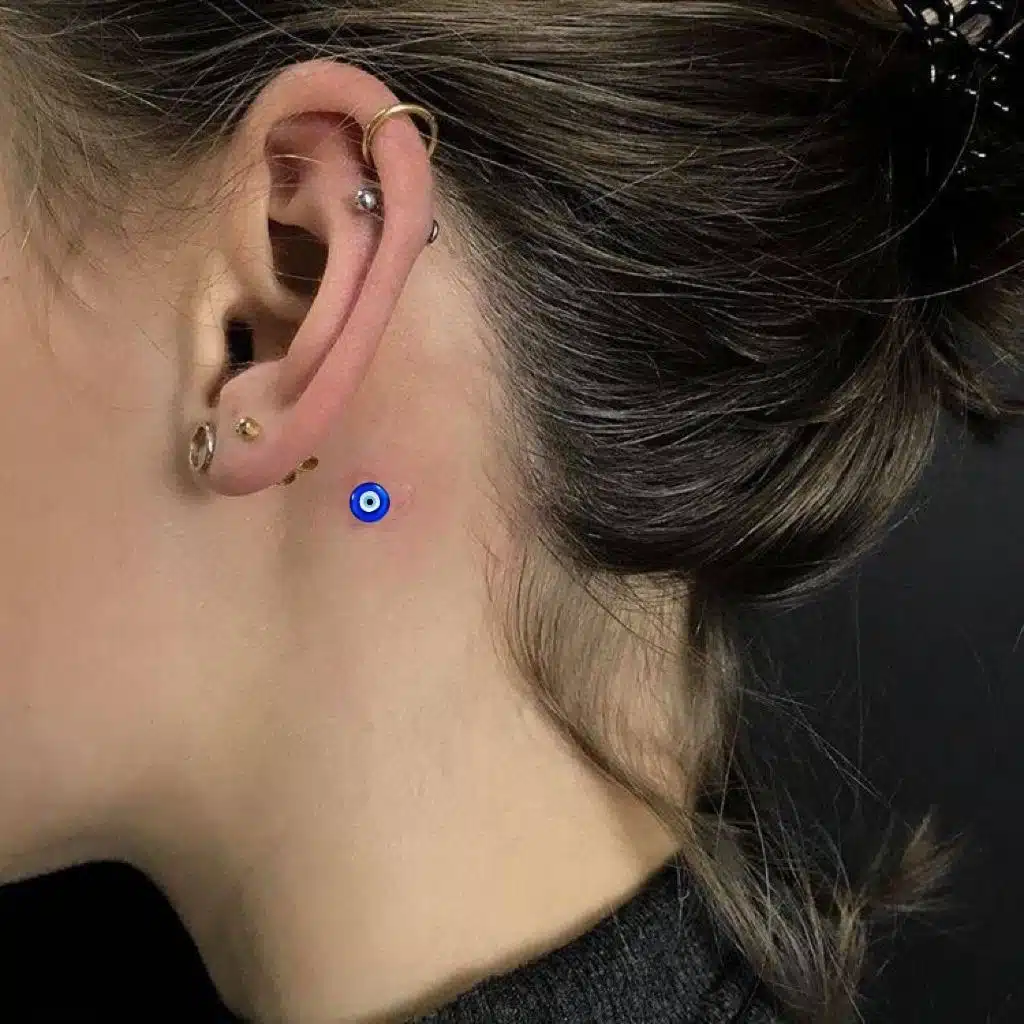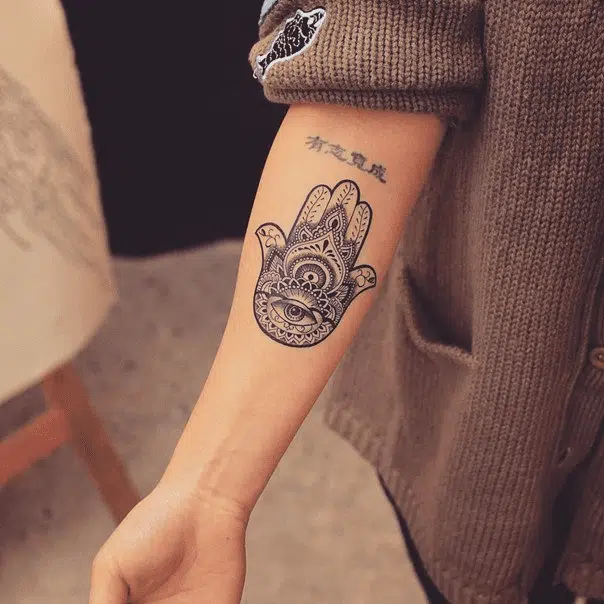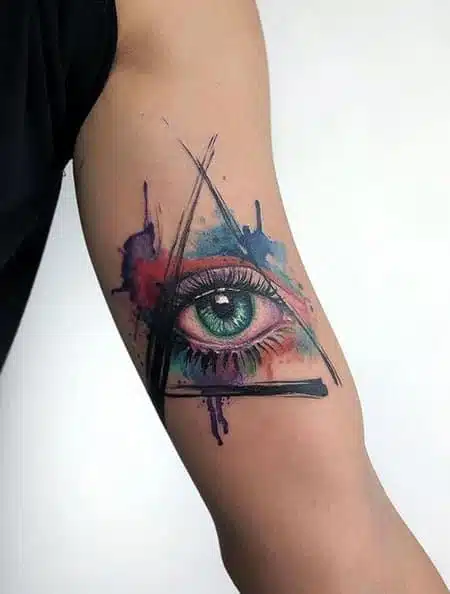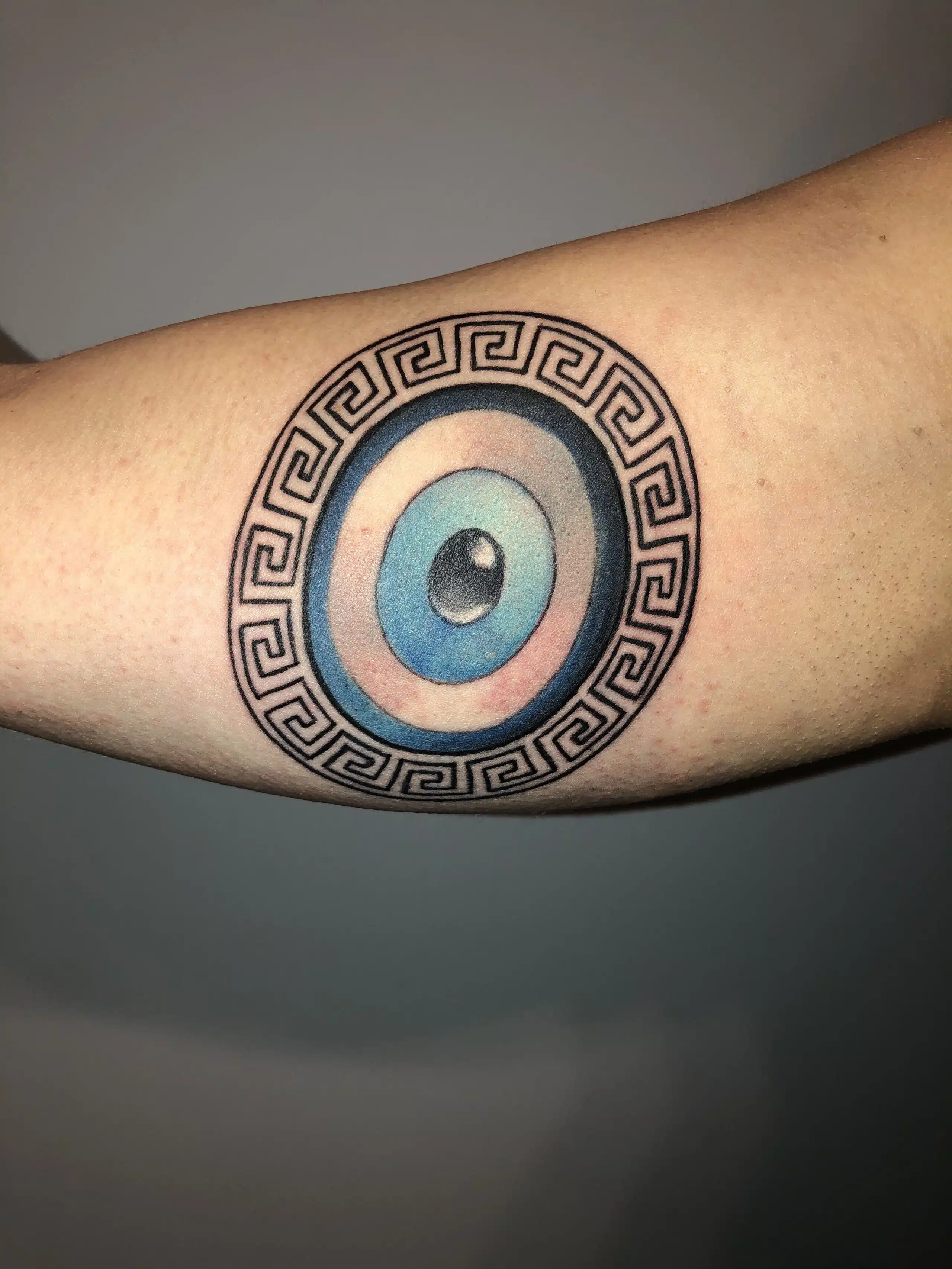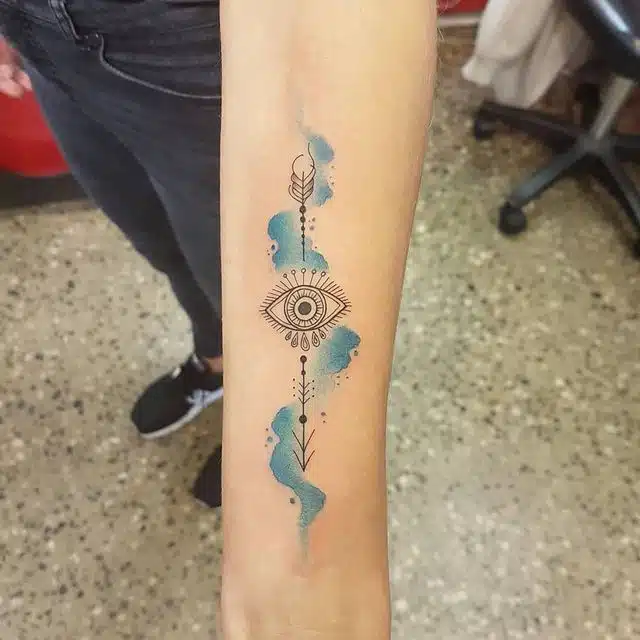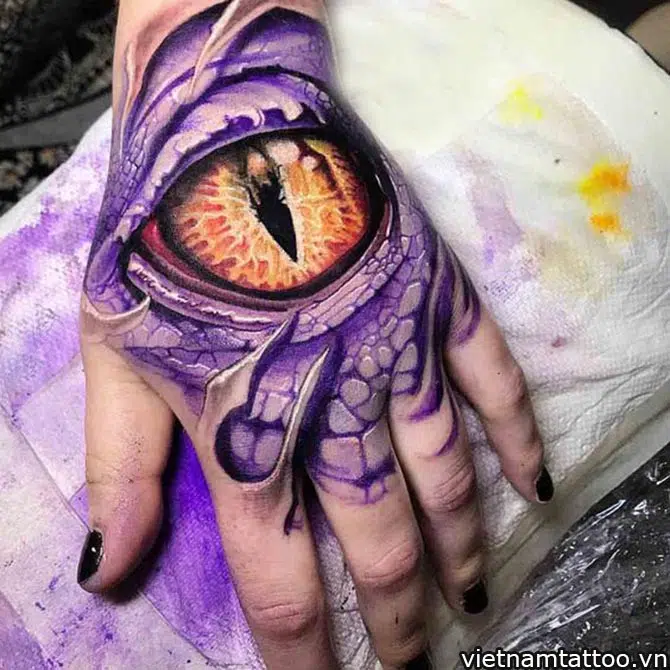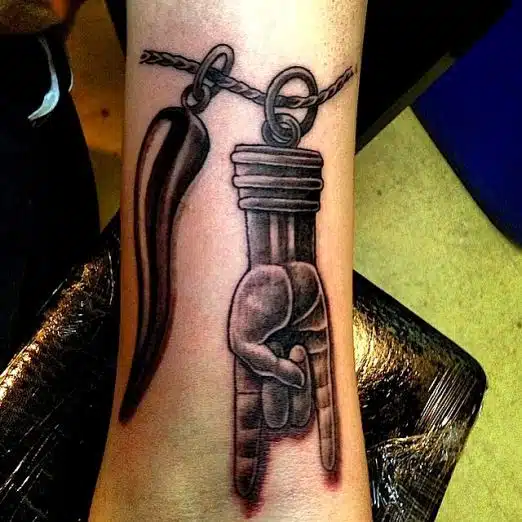The evil eye is a symbol that has been around for centuries. It is believed to offer protection from harm and bring good luck to the person wearing it. The design of the evil eye can vary, but it typically features an eye surrounded by light rays. Many people choose to get an evil eye tattoo to protect themselves from harm. If you are thinking about getting an evil eye tattoo, read on for some ideas and inspiration!
Are you only interested in tattoo designs and want to skip the educational part?
No problem, we got you covered! Click HERE to get inspired.
What does an evil eye tattoo symbolize?
An evil eye tattoo can symbolize several different things. For some people, it is a way to protect themselves from harm. Others believe that it brings good luck and fortune.
The Turkish people traditionally wear this jewelry as a superstitious practice to ward off bad luck, and many cultures worldwide believe in its power.
The evil eye is said to be able to cause harm to those who are not protected against it. It is believed that the power of the evil eye can be harnessed for both good and bad. Several ways to protect yourself from the evil eye include wearing an evil eye charm or tattoo.
If you are considering getting an evil eye tattoo, you should keep a few things in mind, like deciding what you want your tattoo to symbolize.
Do you want it to be a way to protect yourself from harm? Or do you believe that it can bring you good luck and fortune?
Once you have decided on the meaning of your tattoo, you can start to look for design ideas.
Best Evil eye tattoo ideas and their meanings
There are various evil eye tattoo designs, each with its meaning.
Blue evil eye tattoo
This tattoo is said to protect against negative energy and bad luck.
Hamsa hand evil eye tattoo
The hamsa hand is a symbol of protection in many cultures. It is said to protect against the evil eye and bring good luck.
Turkish evil eye tattoo
"Apotropaic" (or protective) means to turn away harm, and this tattoo is said to do just that.
Evil eye triangle tattoo
Triangle tattoos often symbolize family, the soul, and time. They can also represent the self by embodying emotions, thoughts, and feelings. The triangle tattoo with the evil eye is a popular design that people believe will keep away bad luck from their prized possessions.
Greek evil eye tattoo
The Evil Eye is a popular tattoo choice for Greeks. It is said to protect the wearer from bad luck and negative energy. The greek evil eye is also known as "Matiasma." It was considered a danger to individuals who received too much admiration and credit rather than their due.
Evil eye henna tattoo
Henna is commonly utilized in joyful gatherings like weddings and birthdays to mark a special occasion. The Henna paste stands for good health and money in marriage, and the darker the stain, the deeper the love between two people.
All-seeing evil eye tattoo
The all-seeing eye tattoo is most often interpreted to symbolize the omniscient eye of God looking over humanity. Another popular meaning is that it represents benevolent guidance from a god or gods. The word "providence" means "guidance," after all.
Egyptian evil eye tattoo
The Eye of Horus is an ancient Egyptian symbol representing protection, devotion, healing, rebirth, and royal power. It is also used to ward off evil spirits from the living and the dead.
Malocchio Italian evil eye tattoo
Many Italians are superstitious. The Malocchio (mal=bad occhio=eye) or the Evil Eye is one of the most widespread superstitions. It's a look that one person gives to another if they are jealous, according to Italian folklore. Here are some tattoo ideas that are said to ward off evil eyes:
Evil Eye Tattoo Meanings In Different Religions And Beliefs
The evil eye has been mentioned in several different religions and beliefs, including Christianity, Judaism, Islam, and Hinduism.
The Evil Eye, a belief in the destructive power of envy widespread throughout the ancient world surrounding the Mediterranean Sea, is referenced numerous times in Christianity. One such reference is the parable of the laborers in the vineyard (Matthew 20:1-15). The belief in the Evil Eye was widespread among biblical communities, as demonstrated by the numerous references to it in the Bible. This article will review Evil Eye's beliefs, behavior, and some examples of where the belief originated. Furthermore, we will explore how often this topic is mentioned in biblical texts. The thesis of this essay is that the Matt 20:1-15 parable is an example of a cultural script latent in the Evil Eye tale. According to the thesis, the argument is that Matt 20:1-15 is a parable in which envy is condemned as incompatible with life in the kingdom of heaven and harmful to the community's well-being.
In Judaism, several times, the evil eye is mentioned in the classic Pirkei Avot (Ethics of Our Fathers). Some Jews believe that a "good eye" designates an attitude of goodwill and kindness towards others. Someone with this attitude in life will rejoice when his fellow man prospers; he will wish everyone well. An "evil eye" denotes the opposite attitude. A man with "an evil eye" will not only feel no joy but also experience actual distress when others prosper and rejoice when others suffer. A person of this character represents a great danger to moral purity, according to some Jews.
In Islam, the evil eye is a superstition that has been around for ages. It's sometimes known as a phrase used to describe ill luck that passes from person to person due to jealousy or envy. The term "evil eye" refers to harmful negative energy and is frequently used as a synonym for "misfortune." The malignant energy may cause sickness, material deprivation, or the loss of a loved one. The victim's bad luck might be illness, impoverishment, or even a run of bad luck. The person casting the malignancy could do so intentionally or unintentionally.
To protect oneself against the evil eye, Hindus offer prayers to various gods and goddesses in their religion's pantheon. For example, Hindus believe that breaking a coconut in front of Ganesha removes the effects of bad luck. People believed that the amount of jealousy the rival felt towards the devotee was directly proportional to how loud the coconut sounded when it broke. Ganesha, capable of removing all obstacles we may face, can also negate such negative effects.
How To Protect Yourself Against The Evil Eye?
There are a few different ways to protect yourself against the evil eye. One way is to wear an evil eye charm or tattoo. Another way is to avoid looking people directly in the eyes. You can also try to stay positive and surround yourself with good energy.
Who Should Get An Evil Eye Tattoo?
If you are looking for a way to protect yourself from harm and bring good luck, an evil eye tattoo is a great choice instead of wearing a charm all the time. Superstition can be a powerful thing, so this tattoo design not only looks good but gives you a piece of mind as well.
Why Are Evil Eye Tattoos So Popular?
Evil eye tattoos are becoming increasingly popular because they offer protection from harm and bring good luck. The design of the evil eye can vary, but it typically features an eye surrounded by light rays. Many people choose to get an evil eye tattoo to protect themselves from harm.
@sydsmithtattoo Evil eye finger tattoos done this week 🧿 #AEHolidayCard #tattoo #tattoos #finelinetattoo #tattooartist #tattootiktok ♬ original sound - < 3
General Breakdown Of Tattoo Pain Levels On Different Body Parts
Here is a breakdown of the different tattoo pain levels:
- Low: This level of pain is generally described as a mild discomfort or tickling sensation. It is similar to the sensation of getting a light scratch or scrape.
- Moderate: This level of pain is generally described as a moderate discomfort or aching sensation. It is similar to the sensation of getting a deep scratch or scrape or being pinched.
- High: This level of pain is generally described as a strong discomfort or throbbing sensation. It is similar to the sensation of getting a burn or being stung by a bee.
It's important to note that pain tolerance is highly individual and can vary greatly from person to person. Some people may find certain body parts more or less painful than others, and the same body part can be more or less painful for different people. Additionally, the level of pain can be affected by factors such as the size and location of the tattoo, the skill of the tattoo artist, and the individual's own pain threshold.
Tattoo placement pain level chart
Body Part | Pain Level | Explanation |
Forehead | Low | The forehead has few nerve endings, so it is not a particularly painful area. |
Eyebrows | Low | The eyebrows have few nerve endings, so the pain level is relatively low. |
Ear | Low | The ear is a relatively thin and fleshy area, so the pain level is low. |
Nostril | Low | The nostril is a small area with thin skin, so the pain level is low. |
Lip | Low to Moderate | The lip has more nerve endings than some other areas, so it may be slightly more painful. |
Cheek | Low to Moderate | The cheek has a moderate amount of nerve endings, so it may be slightly more painful. |
Moderate | The neck has a moderate amount of nerve endings, so it may be slightly more painful. | |
Moderate to High | The chest has a high concentration of nerve endings, so it can be quite painful. | |
Abdomen | High | The abdomen has a high concentration of nerve endings, so it can be quite painful. |
Back | High | The back has a high concentration of nerve endings, so it can be quite painful. |
Shoulders | High | The shoulders have a high concentration of nerve endings, so they can be quite painful. |
Upper Arms | Moderate to High | The upper arms have a moderate to high concentration of nerve endings, so they can be somewhat painful. |
Elbows | High | The elbows have a high concentration of nerve endings, so they can be quite painful. |
Forearms | Moderate | The forearms have a moderate concentration of nerve endings, so they are not as painful as some other areas. |
Hands | High | The hands have a high concentration of nerve endings, so they can be quite painful. |
Lower Arms | Low to Moderate | The lower arms have a lower concentration of nerve endings, so they are not as painful as some other areas. |
Wrists | Low | The wrists have a low concentration of nerve endings, so they are not very painful. |
Lower Back | High | The lower back has a high concentration of nerve endings, so it can be quite painful. |
Buttocks | High | The buttocks have a high concentration of nerve endings, so they can be quite painful. |
Thighs | High | The thighs have a high concentration of nerve endings, so they can be quite painful. |
Knees | High | The knees have a high concentration of nerve endings, so they can be quite painful. |
Calves | Low to Moderate | The calves have a low to moderate concentration of nerve endings, so they are not as painful as some other areas. |
Ankles | Low | The ankles have a low concentration of nerve endings, so they are not very painful. |
Tattoo aftercare tips
Before getting a tattoo:
Choose a reputable tattoo artist and parlor. Research the artist's portfolio and read reviews from previous clients.
Consult with the artist about the design and placement of the tattoo.
Make sure you are in good health. If you have any medical conditions or are taking any medications that may affect your ability to heal, be sure to let your tattoo artist know.
Consider using a numbing cream to reduce pain during the tattooing process. These creams contain a numbing agent (such as lidocaine) that can be applied to the skin before the tattoo is done. It's important to follow the instructions on the numbing cream and to only use it as directed.
Avoid alcohol, caffeine, and other substances that can thin your blood for at least 24 hours before getting a tattoo.
Eat a healthy meal before your tattoo session to ensure that your blood sugar is stable.
Wear loose, comfortable clothing that allows easy access to the area being tattooed.
After getting a tattoo:
Follow the aftercare instructions provided by your tattoo artist. These may include:
Keeping the tattoo clean and covered with a bandage for the first few hours after getting tattooed.
Washing the tattoo with lukewarm water and a mild soap (such as unscented, antimicrobial soap) and patting it dry with a clean towel.
Applying a thin layer of tattoo ointment or lotion (such as A&D or Aquaphor) to the tattoo and covering it with a clean bandage or wrap.
Repeating this process for the first few days, or until the tattoo has fully scabbed over.
Avoid soaking the tattoo in water for the first week, such as in a bath or pool.
Avoid picking or scratching at the scabs, as this can cause the tattoo to fade or become infected.
Avoid exposure to direct sunlight or tanning beds for at least 2-4 weeks.
If you experience any redness, swelling, or unusual discharge, contact your tattoo artist or a healthcare professional.
Overall, it's important to keep your tattoo clean and moisturized during the healing process to ensure that it heals properly and looks its best. Using a numbing cream can help reduce pain during the tattooing process, but it's important to use it as directed and to follow all aftercare instructions to ensure that your tattoo heals properly.
People Also Ask:
What is a Nazar tattoo?
The evil eye is a belief that someone can harm you by just looking at you, and this design wards off those effects. It's usually made with blue, white, and black concentric circles.
What's the difference between Nazar and evil eye?
The Nazar legend and the evil eye curse are two sides of the same coin, while the evil eye symbol is used to deflect negative energy and may be found on amulets and charms.
Where should you put an evil eye tattoo?
The evil eye tattoo design is most effective positioned over your chest or arm. It is tasteful, appropriate for most people regardless of age or gender, and not too dramatic.
What culture is the evil eye from?
The belief in the evil eye is ancient and widespread; it appears in Greek, Roman, Jewish, Islamic, Buddhist, and Hindu mythology and in indigenous, rural, and other folk cultures worldwide. It has continued to the present day.
Can Muslims wear evil eye amulets or tattoos?
This religion teaches that attributing ultimate influence to anything other than Allah is forbidden. For this reason, it is not permissible to wear evil eye amulets or similar objects to benefit from them.
Watch A Time-Lapse Video Of A Evil Eye Lotus Tattoo Done By A Pro:
250+ Evil Eye Tattoo Ideas for Your Inspiration
Final thoughts:
The evil eye is a popular tattoo because it protects against negative energy and bad luck. There are many different designs, and each has its meaning. Choose the evil eye tattoo that resonates with you and your beliefs. Remember, placement is key for this tattoo - choose a spot where it will be most effective.

